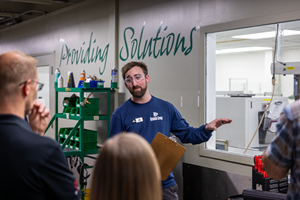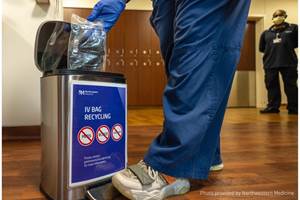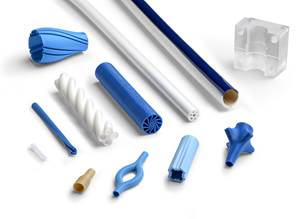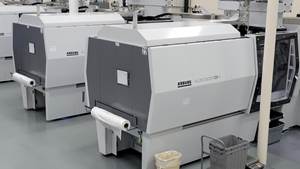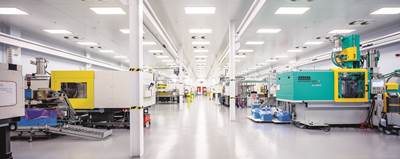Medical and Molding Elite
When Jeff Smith received a notice evicting his promising business out of his house, it could have been the end of Elite Biomedical Solutions’ and Elite Precision Plastics’ stories before they really got started, instead it was just the beginning.

Elite Biomedical Solutions began molding the plastic components of its assemblies for replacement pumps, telemetry units and patient monitoring devices used by hospitals. Source: Plastics Technology
The constant coming and going of UPS trucks in the residential neighborhood was what eventually gained the attention of Clermont County and precipitated the eviction letter, but instead of simply shutting down the home-run operation, a forward-thinking official saw a chance to not only address a local complaint but also assist a budding area business.
“Clermont County kicked him out,” Justin Heileman says, “but, luckily, they had a recommendation for a place for us, and that was this place.” Back in 2012, that new place (which would become Elite Biomedical Solutions) was a 3,400-square-foot vacancy within a 51,000-square-foot building on the eastern outskirts of Cincinnati just off I-275. In time, eight employees became 64, and one business in a 3,400-square-foot space became two businesses occupying 34,000 square feet of the building, with eyes on the remaining 17,000 square feet. In addition, one residential neighborhood saw a significant drop in delivery truck traffic.
Heileman is the chief strategy officer at Elite Precision Plastics, a precision and medical-focused custom injection molder that Elite Biomedical launched amid the COVID-19 crush for medical-related supplies. Elite Biomedical, which began out of Smith’s house, was born out of his perceived need from hospitals for repairs and replacement parts for heavy-use equipment such as IV infusion pumps, patient monitors, telemetry units and more. “Basically, all your assets in a hospital that are running medicine and monitoring patients,” Heileman says of the equipment Elite targets.
It’s more intense for us because we are that third party. We have to be buttoned down with quality, with documentation, with testing.
“That was the concept of that business,” Heileman says. “Jeff saw that there were no third-party companies out there providing replacement parts besides the OEM, and that’s what Elite Biomedical is all about: offering a different solution.” In time, Elite Biomedical brought over a few molds for certain parts that were initially run by another company before Elite began making all the parts in-house.
Considered a third party to the OEM, Elite offers replacement parts for pumps, telemetry units and patient monitoring, but at a discount and with the same quality. “The quality needs to be at the level of the OEM if not better than,” Heileman says. Today, Elite Biomedical — which is ISO 9001 and ISO 13485 certified — has products in around 2,500 hospitals across the U.S., with some in Canada as well.
“One thing we can provide is the same quality, if not better, but at a discount rate,” Heileman says. “It's kind of like an aftermarket part for your car. Instead of going to Ford or Chevy or Toyota, you’re going to look online and get the same part, but at a lower cost.”

Elite has biomedical engineers, or biomeds, on staff to help it target high-use products for replacement parts. Source: Plastics Technology
In consultation with hospitals and using its own in-house biomedical engineers or biomeds, Elite Biomedical reverse engineers parts, scanning components to create 3D models while also determining the material makeup, down to the additive package used. If improvements to the design, including different resins, can be made, Elite Biomedical will assess them, while mostly staying faithful to the original design. “We don't want to veer too much,” Heileman says. “We can enhance that a little bit if there’s an insert or a boss cracking in a certain place — maybe we’re able to add some plastic to that portion to prolong the life of that part — but we can't veer from the design of the part.”
To help it make those determinations, Elite has four biomeds in-house, with another two employees working toward that certification, as well as field biomeds in Chicago and Indianapolis, plus two more in Texas. “We work closely with our partners around the country,” Heileman says. “The hospitals have recommendations and say, ‘This is a part that we utilize a lot, and there's no other company besides the OEM that produces it. Can you guys take a look at it?’’’
Moving Into Molding
Elite Biomedical added three machines in 2017 — 50-, 100- and 200-tons — and started molding in-house in 2018. When the company decided to launch Elite Precision, it added another two 200-ton presses with portable clean room enclosures. All of these machines are fully electric Milacron Roboshots. In 2024, it installed a 55-ton vertical press from Arburg to take on insert molding. The space now occupied by these six molding machines used to be a “catch all,” according to Heileman, acting as storage. When the company elected to bring in molding, new floors were installed, as were upgrades to the space’s electric and water utilities. In addition to molding, secondary operations include heat staking/inserting, ultrasonic welding, assembly, laser etching, pad printing, epoxy and light curing. For parts that require EMI shielding, Elite contracts with a company in Chicago.

Elite follows all the documentation protocols and more required by the medical industry for its output of medical components. Source: Plastics Technology
“When we started Elite Precision Plastics, we were going after labs and diagnostics companies,” Heileman says. “During COVID, you saw a lot of the articles coming out that these labs didn’t have enough supplies; they didn't have the pipettes, they didn't have the transport tubes or the syringes that they needed.”
Travelers and Golden Parts
Working in medical means having full visibility into every part’s history — from the batch of resin from which was fabricated and the machine it was molded on to the process parameters that created it. “Being in the medical field, you have to have identification and traceability,” Heileman says. For Elite, this means it has “travelers” that go along with all its production and document everything about that part. “Every time we manufacture product, whether it’s 500 parts or 100,000 parts, we have to have a traveler that goes with that part.”
In terms of materials, the company deals almost exclusively in engineering resins, running everything from TPE and PP to Ultem, LCP and nylon 6. Because of the need to maintain replacement part inventory for the Elite Biomedical business, the company has a wide range of production volumes for any given component, running from 500 to 5 million pieces, with part weights from 1 to 300 grams, mold cavitation up to 32, and tolerances down to 0.005 inch, according to Heileman.

Elite molds all the plastics elements of its replacement pumps with part sizes from 1 to 300 grams and tool cavitation up to 32. Source: Plastics Technology
Production is tracked as it’s happening for quality purposes, including measurement of startup parts, in-process and end-of-day inspections. Each part has its own booklet, including part drawings and process parameters required to ensure production is up to snuff. Also so-called “golden parts” — first shots ever off a mold — are also held. “We keep the ‘golden’ parts just in case,” Heileman says. “If we notice something, we can refer back to that part, and say, ‘Yeah, this was here,’ or ‘No, it was not here. We need to look at the process or the part or the mold to figure out what’s going on.’”
Testing, Testing, 1..2..3
Postproduction and inspection, many critical parts go through even more testing protocols to ensure they’re functioning properly, with some of that testing taking months to complete. When Plastics Technology visited, a cobot was repeatedly opening and closing a battery enclosure to determine how many cycles it will endure until failure. To test something called the air-in line, which ensures no air bubbles enter a patient, Elite Biomedical built its own testing device. The component features two molded halves welded together with piezo chips on either side of the line feeding the patient. The presence of a bubble would interfere with the signal between the two chips, triggering an alarm, but to do so, the chips have to be perfectly parallel to each other. Another in-house device enables precision insertion via a linear sensor so the inserts are placed at the same depth every time despite variations in the pneumatic air used to press them in. For many of these testing devices, RFID tags on the individual fixtures loads all the matching presets for that job, whether those are heat, dwell time, depth or more.
This level of precision is not new to medical, but it’s taken to intensified levels at Elite given its position between OEMs, hospitals and patients. “It’s more intense for us because we are that third party,” Heileman says. “We have to be buttoned down with quality, with documentation, with testing.”

Used to deliver critical medicines to patients via pumps, many of the components molded by Elite require adhering to extremely tight tolerances.Source: Plastics Technology
Related Content
Medical Molder, Moldmaker Embraces Continuous Improvement
True to the adjective in its name, Dynamic Group has been characterized by constant change, activity and progress over its nearly five decades as a medical molder and moldmaker.
Read MoreBaxter to Scale Up PVC Intravenous Bag Recycling Program
Successful pilot program with Northwestern Medicine will expand to additional units and health systems.
Read MoreDuPont Buys Medical Product Manufacturer Spectrum Plastics
Purchase price of $1.75 billion for leading supplier of extruded, molded, and 3D printed medical components.
Read MoreConsistent Shots for Consistent Shots
An integral supplier in the effort to fast-track COVID-19 vaccine deployment, Retractable Technologies turned to Arburg and its PressurePilot technology to help deliver more than 500 million syringes during the pandemic.
Read MoreRead Next
Minding Your P’s and Q’s (and Your I’s and O’s) in Medical Molding
Process validation—including Installation Qualification (IQ), Operational Qualification (OQ), and Performance Qualification (PQ)—is a necessary but time consuming procedure, what if you could speed it up?
Read MoreGetting Started with Medical Molding: First Consider the ‘Four E’s’
Global medical molder Nypro provides first-hand guidance on what you need to get into the medical molding business.
Read MoreSeeking Better Balance in Medical Molding
Medical injection molding demands shot-to-shot consistency of part and process—a fundamentally challenging task in multicavity molding—is there better path to flow balance?
Read More















